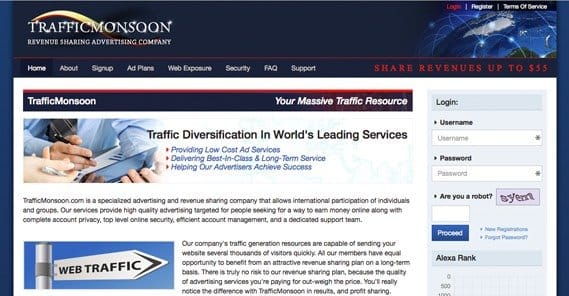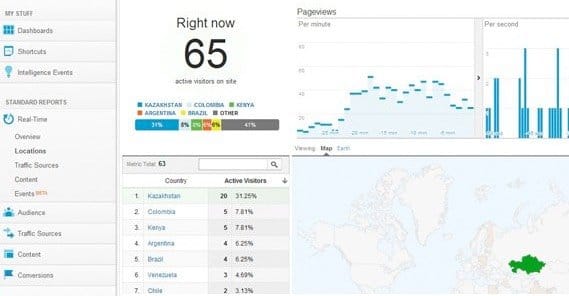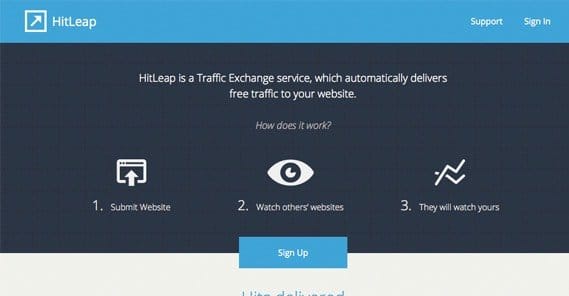42 Traffic Exchange Websites to Get Free Visits Automatically

Traffic exchanges have a long and variable history in the world of Internet marketing. At times they have been incredible effective. At other times they have been nothing short of scams. Exchanges of all stripes exist today, with some of the best hidden behind walls of reviews and bans.
How Traffic Exchanges Work
In concept, the traffic exchange is a brilliant idea. Years ago, when the Internet was young and marketers were well meaning and naïve, they worked very well.
The idea works like this. You have a website, and you want others to see it. Your friend has a website of their own, and they want others to see it too. You send your website to your friend and tell them to look at it, and if they do, you’ll look at their site too. Now scale this up; instead of you and your friend, you have thousands of marketers with websites they want seen.
The traffic exchange itself is a central hub that regulates websites and views. You register for the site, because you want your site to be viewed by other users. The traffic exchange puts a bit stop sign in front of you and points towards the pool of other websites already in the system.
In order to have your site viewed, you need to spend credits. You earn credits by viewing other websites. When I talk about a ratio below, that ratio is typically how many views you need to make before you earn a credit. Most traffic exchanges also offer you the ability to purchase credits with money, to bypass the time-consuming process of viewing other pages just to get yours viewed.
The Problem With Traffic Exchanges
In a perfect world, with everyone on the up and up, a traffic exchange would be a perfectly valid and legitimate way of sharing a website. You would have webmasters from across the country, in all niches, sharing their sites. It would be like StumbleUpon; you could select interests, browse sites that interest you, and all the while earn credits to have your site added into the rotation.
We don’t live in a perfect world. Someone, somewhere, way back in the dark ages of the Internet, created a piece of software that would view a website for them in the background while they did other things. This would earn them credits for the traffic exchange, which they could then spend for legitimate views from real users. They were essentially injecting fake traffic into the rotation and pulling legitimate traffic out.
This grew more and more widespread as people discovered the technique, bought similar software, and put it to use. The trouble is, for every user fake browsing, the quality of the traffic from the exchange drops. If 50% of the users of a traffic exchange are using bots to browse to earn credits, 50% of the traffic they – and the legitimate users – receive will be fake traffic. And that’s at a 1:1 ratio. It gets worse when the exchange requires more views for a credit.
About Manual Exchanges
There are two types of traffic exchanges; the manual and the autosurf. Consider the above problem scenario with traffic exchanges. There are two ways to solve this problem.
The first way to solve the problem is to heavily regulate the traffic exchange. You would need to sample traffic and monitor the actions of the people browsing through your network. Any time you detect a bot, you would need to block that bot, invalidate the credits earned through the bot, and warn or potentially ban the user running the bot.
Manual traffic exchanges take this route. They heavily enforce ratios, they ban users who use bots, and they often require a human interface action such as a captcha in order to prove you’re not a robot doing the browsing. They almost all require a certain amount of time spent on a given site in turn, in order to encourage actual usage of the site.
I’ll talk about the other solution to the problem in a minute; first, though, let’s look at the names that come up frequently in the world of manual traffic exchanges.
High Quality Manual Exchanges
These exchanges are all on the top side of legitimate, or as close as possible. They filter their sites to remove malware and malicious sites, they ban people trying to abuse the system, and they have high volumes of hits.
- Traffic Monsoon – This exchange has a 2:1 ratio and a 20-second timer on surfing, but it does allow automatic rotators. It doesn’t require a login to surf. It’s been steadily growing from month to month and broke 20 million hits tracked as of June 2015.
- EasyHits4u – This exchange has a ratio of 1:1 and only a 15-second timer. They allow rotators and don’t require a login. They’re significantly smaller than Traffic Monsoon, with only 600,000 tracked hits. As a bonus, they have five referral tiers for marketers looking to recruit others.
- TE Racing League – This exchange has a somewhat rocky history, going up and down in hits from month to month, taking a dive in May. They have a 3:1 ratio but only a 5-second timer.
- Legacyhits – this exchange has been holding relatively steady over the last few months, with only a minor decline in May and June. They have a 10-second timer and do not require a login, but their ratio is only 2:1. They have nearly 1.5 million tracked hits on average.
- Surfers2u – This exchange has a 4:3 ratio, which is unusual among the higher quality exchanges. It also does not allow rotators. It doesn’t require a login, at least, and they have around a quarter million tracked hits on average.
- I Love Hits – This exchange has a 3:1 ratio and a 6-second timer. They allow rotators and have no login for surging. They have a referral program, but it only has one level, so the bonus is flat for each referral.
- StartXchange – This exchange has a 3:1 ratio and a 10-second timer, making it about par for the course. It allows rotators, has no login, and has tracked over two million hits. There’s not much that makes it stand out compared to other exchanges.
- TopHits4U – This exchange has a 3:1 ratio and a 10-second timer. Sound familiar? Like StartXchange, there’s nothing that really sets this network apart from others on this list.
- Easyhits2u – Another exchange that has a 2:1 ratio, a 10-second timer, no login, and rotator permissions. This is the problem with many of these networks; there’s nothing that makes them stand apart from others on their tier.
- ThumbVu – this exchange has a 3:1 ratio, a 10-second timer, rotators, and all the same as the rest. The one major difference is that it requires a login if you want to surf, unusual for the top tier exchanges.
- Tezak Traffic Power – One of the more originally named exchanges, this one pulls out at the bottom of the “high quality” list with a 3:1 ratio, an 8-second timer and the same rotator permission as most of the other networks.
Low Quality Manual Exchanges
I’m not going to go into detail about these exchanges, as you probably shouldn’t even visit them. In general, they’re all low volume, with either a lot of bad traffic or a lot of bots circulating through their networks. Remember, these are just a selection of the hundreds of bad traffic exchanges out there.
- Hit Hiefer
- Surf Central Net
- Firedragon-Hits
- AdsTab
- Global Traffic 4You
- WatersEdgeHits
- Free Web Clicks
- Surfers Traffic Exchange
- Badger Hits
- Lighthouse-Traffic
About Autosurf Exchanges
Now, think back to the problem scenario. Your traffic exchange is large, it has thousands of users, if not hundreds of thousands. There are millions of hits flying around every week. It’s impossible for you to manage the exchange and enforce quality. You could use algorithms, but algorithms can be beaten, and you don’t have the time, knowledge or budget to develop them faster than your legion of users can beat them.
Rather than attempt to fight off the bots, you embrace them. You remove any text on your site guaranteeing the quality of the traffic in the exchange. You drop prices on credits and raise ratios to encourage bot usage. You enable applications that rotate through sites automatically, changing up user agent and HTTP referrer as they go. You add a widget that dynamically changes the amount of time the bot spends on each site, and you virtually remove timers on viewing each site.
This is what an autosurf exchange is. You don’t need your users to run a bot; you embed the bot in your exchange software itself. All the user has to do is hit play, wait a while, then redeem their credits.
The problem with an autosurf network, of course, is that all of the traffic coming through it is coming from a bot. The people using these networks all know that the traffic is bot traffic, and it’s all very, very hard to use for anything legitimate. Bot traffic like this can get you booted from programs like Google AdSense, and most other sources of display ads.
Now, I’m going to list a bunch of autosurf exchanges, some good and some bad. Before you read on, though, I just want you to remember that even the best autosurf is still poor quality traffic, and will fare poorly compared to even bad manual exchanges.
High Quality Autosurf Exchanges
Autosurfs are only good for very specific purposes. You can make money with them, but you have to have a site set up to use them. Traditional splash pages and high value but low converting sales don’t work. You’ll have high traffic volume but low click rates. Plan accordingly.
- Hitleap comes out on top with the ability to set visits per hour on individual URLs. You can hide the referrer as well.
- Homepage Exchange I rank second with their custom timer. They allow you to convert minutes into cash, and they have a good referral program.
- eBesucher is a high quality site but it caters exclusively to a German audience. They have good targeting and a lot of members, if you can appeal to their niche.
- 247AutoHits sounds like a poor piece of software, but it’s a decent autosurf network with commissions for referred members who upgrade their accounts.
- Otohits has a custom time and a custom HTTP referrer, which is a lot of control that poor sites don’t give you.
- SmileyTraffic has a 20 second timer and over 170,000 members, so it can produce a lot of volume very quickly.
- WebSyndic is primarily notable for having decent geotargeting, and for having a hybrid English and French audience.
- Twistrix has custom timers and the option to hide the HTTP referrer, though you can’t customize it as you can on some other networks.
- FeelingSurf is a French-oriented page with a very modern interface, and they give you the option for unique visitors only, to eliminate unnecessary repeat visits.
- EliteAutosurf is notable only for their weekly contest for referrals, which can award advocates cash prizes.
- GlobalBlaster and GlobalHits are two networks operated by the same company and are really the same wide network, so you can sort of access both from one or the other.
Low Quality Autosurf Exchanges
One thing you’ll note about the list I’m about to show you is that they’re all aimed at foreign countries. I say this as an American writing to an America-centric audience. Perhaps these networks are decent for people within their demographics, but I’m not one of them, so I can’t much test it out.
- CrunchingBT
- 24Besucher
- Auto-Surf.de
- Websurf.cz
- AutoSurf.sk
- Auto-surf.pl
- AutoVisitor
- 360clicks.de
- Lautosurf
- Autosurf.fr
Believe it or not, despite the similar names, they’re not all run by the same company. They’re just networks that used formulaic setups on URLs they bought quickly to make sure they had a claim.
How to Use a Traffic Exchange Effectively
With both manual and autosurf exchanges, there’s one big lingering problem. Remember my analogy likening them to StumbleUpon? Well, it’s not quite accurate. StumbleUpon has a wide array of interests and topics for users to browse. There are millions of pages in their database, categorized by interest and delivered to interested people.
Traffic exchanges may have started out that way, all the way back in 2001, but they have long since decayed. As their reputation fell, it required more and more knowledge and more tricks to use them effectively. As the barrier to entry rose, the niches willing to use them dropped out. These days, the only people really interested in using a traffic exchange are the people who want to abuse them to make quick money online. These people have sites typically geared towards making money online, to help out each other and to make a profit off of their knowledge.
Therefore, these days, you can only really make a profit out of a traffic exchange, manual or autosurf, by running a website in a niche geared towards making money online. It might be about boosting traffic, it might be about running ads, it might be about traffic exchanges themselves; there are any number of variants of the niche. The fact is, though, you won’t see cooking blogs and automobile blogs and mountain climbing blogs in the rotation. The traffic using the exchange is only interested in getting value out of it, so the only way to make money from those users is to cater to their interests; making money out of blogging.
What other tips can you use to optimize your usage of traffic exchanges?
Use a lot of them. One traffic exchange limits you. Two limits you less. See, each exchange tends to have a surprisingly small set of active users, so you can run into issues seeing the same sites more than once. Exchanges typically only count the first unique view of a day, so it earns you no credits and it does you no good to encounter the same site twice.
Additionally, most exchanges have a timer you need to exhaust before you can move on to the next site. If you earn a credit for every three sites you view, and it takes you 20 seconds to exhaust the timer on each site, that’s one credit per minute. If you add in a second traffic exchange with the same statistics and rules, you’re earning two credits per minute; you just need to have another browser window open for that other exchange.
To avoid having all of your credits used up by showing your site to the same people over and over, you can use more than one exchange as well. Rather than stacking 50 credits on one site, you stack 10 on five sites. Each site tends to have a different active audience, so you’ll get more unique views.
As for extracting value from the users browsing your site, use a splash page. These users aren’t going to bother scrolling down, they just want to get in and out. You have exactly the size of one browser window to capture their attention and get them to explore your site instead of surfing away.
You’re also never going to convert these users into paying for a product from your splash page. Don’t even try. Instead, try to get them to opt in to a mailing list. Providing an email in exchange for some free bit of value is a lot more enticing than exchanging dollars for a product. You can follow up the opt-in with a sales pitch later.
If you’re lucky, you’ll rack up enough credits throughout your various exchanges to get a decent number of people browsing your site, and while they do so, some will become interested. You can explore those leads at your leisure, and sell them products through force of personality and salesmanship, rather than through a landing page pitch.
 ContentPowered.com
ContentPowered.com












Good morning. Can I use, for example, Trafficmonsoon on my blog created with Blogger (Google’s Blog) ?
Awesome stuff, thank you. Any harm in using multiple sites like this simultaneously?
One of the best articles about traffic exchanges I’ve ever read